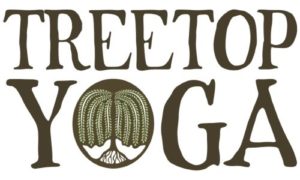What does it mean to create a culture of consent? In an era of #MeToo, and the challenges of male-female consent, I believe Treetop Yoga is one of the best places to help people learn how to say no, how to say yes, and how to receive.
Since autumn 2018, I have assisted Coley Bryan in restorative yoga classes. I am there to observe, learn, and provide additional assists. I have also learned how language can positively shape culture. As students move through initial postures, (most typically in an early Downward Dog), Coley will announce “Heidi and I will be offering hands on assists this evening. If for any reason you wish to NOT be touched, please raise a leg so we know to respect your space.” He pauses, we observe, he says, “Thank you.”
I love this invitation to say no, in an anonymous, non-verbal manner. The teacher asks, the student permits. This is a powerful dynamic because all parties have agency and take responsibility for their own safety. By raising a leg instead of saying, “No” or waving someone off when they approach, students provide clear, but anonymous, boundaries. We take note of who is opting out and let them be.
How important to create a space where there is intimate touch between strangers, and a manner to communicate! Students have agency and opportunity to ask for what they do or do not need. In my experience, most students do NOT opt out but they have been given the chance to do so. This is important. They have been offered a choice, using respectful language. They have been offered the opportunity to advocate for themselves and their needs.
Coley asks every time and every class, even when he knows every student in the room. There may be a day when someone indicates ‘No.’ It may be as simple as having a sunburn, or shingles, or as complex as a history of trauma. It may be the baby or toddler climbing and tugging all day long. It may be recovering from a simple surgical procedure or injury.
This practice recognizes that there is a teacher student dynamic regarding consent. Both parties have a responsibility to communicate clearly. Unlike using a chip or a stone to indicate ‘opting out’ of hands on assists, this practice normalizes consent and includes the spoken words of ‘I know to respect your space.’ Although the students do NOT say yes or no with their voice, they hear Coley ask for permission.
Perhaps this example is merely one teacher, in one studio, in one community, but I believe there is a ripple effect. When female students hear a male teacher ask permission to touch them, it disrupts the dominant paradigm. When male students hear a male teacher ask permission to use hands on assists, it provides a model of clear consensual language. What would the world look like if people asked before touching?
We know our yoga practice is not solely exercise on a mat. Ahimsa, or non-harming, is the most basic of the Yamas. No teacher ever intends to hurt their student but it happens. Some students don’t want to be stirred out of their focus to ‘wave off’ the teacher or say, ‘no thanks’ when approached. The simple routine of asking for and receiving consent to touch another human being creates a new expectation that benefits everyone.
Women and girls are socially conditioned to say yes, to deny their right to pleasure and to keep quiet. To give women an opportunity to set boundaries is to empower them and it has a valuable effect. What may seem a simple question just may revolutionize how we say yes, how we say no, and how we listen to one another.
Written By: Heidi Wakeman

